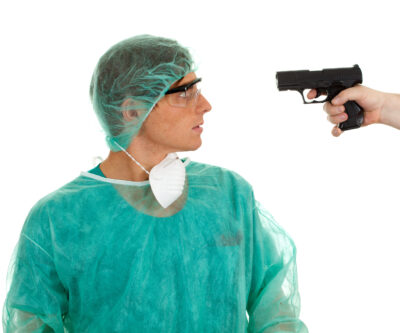Today, two interesting events coincided: the release of IAHSS Gun Screening Standards and the killing of a hospital guard in the lobby of the New Hampshire Psychiatric Hospital in Concord. According to AP News, the victim was named Bradley Haas, 63, a longtime resident and 28-year law enforcement veteran, who was working security (unarmed) in the lobby of the hospital when a lone gunman entered the lobby and shot him dead. The gun screening process mentioned above is to keep weapons from getting into the facility, and while it is not possible to get inside the head of the shooter, we can say that, as a former patient, the shooter would have known of the process. We can’t tell if it would have deterred the attack, given his mental state.
 Police said John Madore walked into the New Hampshire State Hospital just after 3:30 p.m. Friday, armed with a 9mm pistol with additional ammunition, and shot Haas before being shot and killed by a state trooper, according to wcvb.com. In addition, “Madore, a 33-year-old transient man, had a history of mental health issues and had been a patient at the hospital in the past,” and “Madore was a defendant in an assault case in 2016 and was facing charges of second-degree assault, simple assault, and reckless conduct. A judge-ordered competency evaluation as Madore to undergo a part of the case, and the results were sealed in 2017. Charges were dropped, and the reason is unclear.
Police said John Madore walked into the New Hampshire State Hospital just after 3:30 p.m. Friday, armed with a 9mm pistol with additional ammunition, and shot Haas before being shot and killed by a state trooper, according to wcvb.com. In addition, “Madore, a 33-year-old transient man, had a history of mental health issues and had been a patient at the hospital in the past,” and “Madore was a defendant in an assault case in 2016 and was facing charges of second-degree assault, simple assault, and reckless conduct. A judge-ordered competency evaluation as Madore to undergo a part of the case, and the results were sealed in 2017. Charges were dropped, and the reason is unclear.
Madore was shot and killed by responding State Police, leaving a death toll of two: an innocent employee and a mentally unstable shooter.
At CHCER, we have advocated for increased firearms safety and security for over ten years, as seen in our article published in the Journal of Healthcare Protection Management back in 2010, commenting on the feeble response of Johns Hopkins in the wake of an active shooter event at their facility.
Most healthcare facilities have many visitors, patients, and essential medical staff on hand, and thus, any shooting incidents can result in mass casualties. Therefore, the hospitals are soft targets to someone determined to cause mayhem and chaos. Most hospitals are rich in targets, and if there is an active shooter in a critical sector, it can lead to a cascade of events with a high number of deaths. For example, a shooting in the emergency room can paralyze the hospital as it is the core area where patients are resuscitated. Injured individuals have nowhere else to go without a viable emergency room for help.
According to the (Must Read) Active Shooter Response Report from NIH, Since 2000, there have been 154 hospital-related shootings involving 148 hospitals. The events resulted in 235 injuries, some of which included deaths. In the last decade, the incidence of hospital-related shootings appears to be increasing annually. Hospital shootings are known to occur in hospitals of all sizes. Over the past two decades, at least 51% of shootings have occurred in hospitals with less than 40 beds. However, as the number of hospital beds in a hospital increases, the number of shootings drops, perhaps indicating that small hospitals are more accessible to maneuver and have less stringent security. [13], [14]
About 60% of shootings have occurred inside the hospital and 40% outside the hospital. The most common locations for the shootings include the following:
- Emergency department (highest)
- Outpatient clinic (second highest)
- Parking lot
- Patient rooms
- Intensive care unit (ICU)
Who is the Shooter?
In more than 90% of cases, the shooter is a male. While many shooters have been young males, in some cases, shooters have been seniors. In this case, the shooter was male.
What is the Motive for the Shooting?
We do not have the final information concerning this shooting. Still, we do know that the shooter was treated at the facility for a mental condition, and so he probably fits the scenario of mental instability. Other typical motivations include:
- Grudge
- Treated poorly.
- Revenge
- Ending the life of an ill relative with terminal cancer or severe dementia
- Ideology
- Political beliefs
- Suicide
- Prisoner escape
- Mentally unstable patient with false beliefs such as paranoia and delusions
- Complications from a medical procedure or surgery
Who are the Victims?
In most hospital incidents, there is one active shooter and one victim. Only in about 10% of incidents were there more than three victims. Tragically, when there are multiple victims, at least 60% to 80% have been innocent bystanders. The rest include physicians (3%), patients (13%), and nursing staff (5%).
After the shooting, nearly 50% of the shooters committed suicide. The active shooter is captured alive less than 10% of the time.
In this event, the victim was a security guard, and it is not clear whether there was a relationship between the shooter and the victim, and the shooter was not captured alive.
What Weapons are Used by the Active Shooter?
In most cases, the active shooter will use a firearm. In rare cases, the active shooter may also use other weapons and/or even improvised explosive devices that cause more injuries and act as an impediment to law enforcement and emergency responders.
This shooter entered the hospital with a 9mm pistol and “additional” ammunition, and police found a van in the parking lot that contained an AR15 long rifle and ammunition.
Responsibilities of Employers
 In the past, most workplaces in the United States had no plans for dealing with active shooter incidents. However, the number of shooting incidents has promoted most healthcare facilities to initiate measures to prevent or decrease the risk of active shooter incidents. Ultimately, each facility is responsible for its level of security based on planning, mitigation, security infrastructure, and how much the management is willing to invest in creating and maintaining a safe environment. Plus, in all government and healthcare facilities, OSHA also has made recommendations for employers. [20], [21] Some of the OSHA recommendations include the following:
In the past, most workplaces in the United States had no plans for dealing with active shooter incidents. However, the number of shooting incidents has promoted most healthcare facilities to initiate measures to prevent or decrease the risk of active shooter incidents. Ultimately, each facility is responsible for its level of security based on planning, mitigation, security infrastructure, and how much the management is willing to invest in creating and maintaining a safe environment. Plus, in all government and healthcare facilities, OSHA also has made recommendations for employers. [20], [21] Some of the OSHA recommendations include the following:
- The workplace must offer employees a safe and free place from physical hazards.
- The workplace should employ best practices and industry standards to ensure worker safety.
- The workplace must follow all state and federal guidelines when it comes to safety.
- Educate and create awareness among healthcare workers about the possibility of an active shooter.
- Incorporate preventive measures from past shooting events.
Finally, it is essential to be aware that healthcare facilities that are not compliant with OSHA recommendations can be held legally liable for any injuries or deaths that occur during an active shooter incident. Several lawsuits have already been filed in court that have accused the facilities of inadequate security or negligence. [23], [24]
However, after fifty years of hospital safety and security experience ranging from combat field hospitals to some of the largest medical centers, it is clear that the existing mechanisms to keep hospitals safe have failed due to an overly profit-centric attitude by hospital boards, and passing the buck on Safety and Security to weak accreditation mechanisms such as TJC, where once accredited, one assumes that the TJC umbrella covers all Physical Safety and Security risks of the facility – which is not the case.
NB: The majority of the text from this post is repurposed from the aforementioned Active Shooter Report from the National Library of Medicine under the National Institutes of Health.






0 Comments